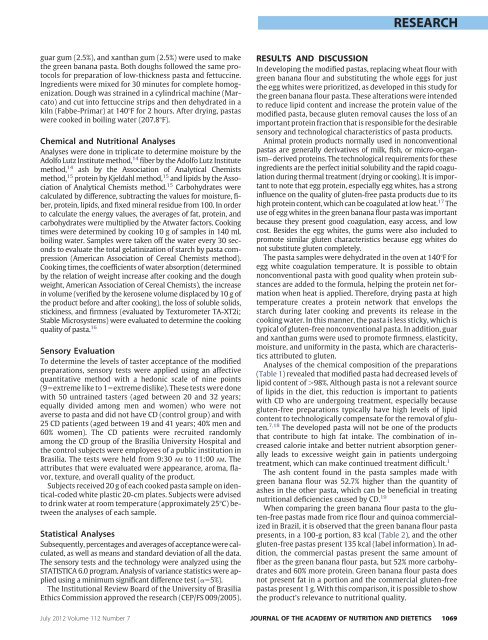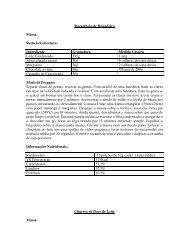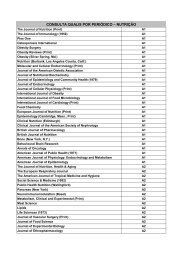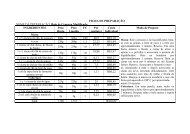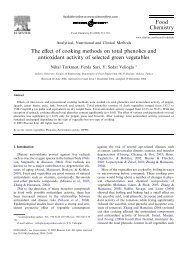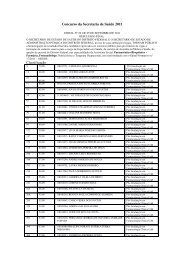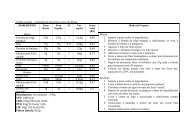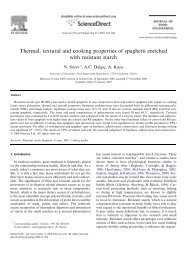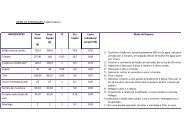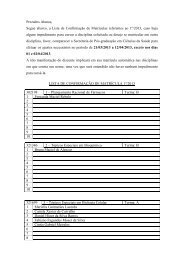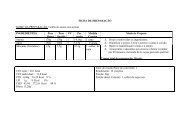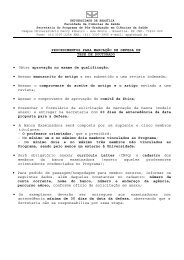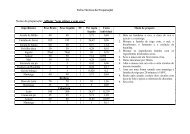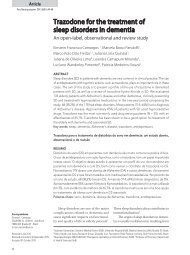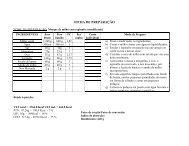Green Banana Pasta: An Alternative for Gluten-Free Diets
Green Banana Pasta: An Alternative for Gluten-Free Diets
Green Banana Pasta: An Alternative for Gluten-Free Diets
You also want an ePaper? Increase the reach of your titles
YUMPU automatically turns print PDFs into web optimized ePapers that Google loves.
guar gum (2.5%), and xanthan gum (2.5%) were used to make<br />
the green banana pasta. Both doughs followed the same protocols<br />
<strong>for</strong> preparation of low-thickness pasta and fettuccine.<br />
Ingredients were mixed <strong>for</strong> 30 minutes <strong>for</strong> complete homogenization.<br />
Dough was strained in a cylindrical machine (Marcato)<br />
and cut into fettuccine strips and then dehydrated in a<br />
kiln (Fabbe-Primar) at 140F <strong>for</strong> 2 hours. After drying, pastas<br />
were cooked in boiling water (207.8F).<br />
Chemical and Nutritional <strong>An</strong>alyses<br />
<strong>An</strong>alyses were done in triplicate to determine moisture by the<br />
Adolfo Lutz Institute method, 14 fiber by the Adolfo Lutz Institute<br />
method, 14 ash by the Association of <strong>An</strong>alytical Chemists<br />
method, 15 protein by Kjeldahl method, 15 and lipids by the Association<br />
of <strong>An</strong>alytical Chemists method. 15 Carbohydrates were<br />
calculated by difference, subtracting the values <strong>for</strong> moisture, fiber,<br />
protein, lipids, and fixed mineral residue from 100. In order<br />
to calculate the energy values, the averages of fat, protein, and<br />
carbohydrates were multiplied by the Atwater factors. Cooking<br />
times were determined by cooking 10 g of samples in 140 mL<br />
boiling water. Samples were taken off the water every 30 seconds<br />
to evaluate the total gelatinization of starch by pasta compression<br />
(American Association of Cereal Chemists method).<br />
Cooking times, the coefficients of water absorption (determined<br />
by the relation of weight increase after cooking and the dough<br />
weight, American Association of Cereal Chemists), the increase<br />
in volume (verified by the kerosene volume displaced by 10 g of<br />
the product be<strong>for</strong>e and after cooking), the loss of soluble solids,<br />
stickiness, and firmness (evaluated by Texturometer TA-XT2i;<br />
Stable Microsystems) were evaluated to determine the cooking<br />
quality of pasta. 16<br />
Sensory Evaluation<br />
To determine the levels of taster acceptance of the modified<br />
preparations, sensory tests were applied using an affective<br />
quantitative method with a hedonic scale of nine points<br />
(9extreme like to 1extreme dislike). These tests were done<br />
with 50 untrained tasters (aged between 20 and 32 years;<br />
equally divided among men and women) who were not<br />
averse to pasta and did not have CD (control group) and with<br />
25 CD patients (aged between 19 and 41 years; 40% men and<br />
60% women). The CD patients were recruited randomly<br />
among the CD group of the BrasÎlia University Hospital and<br />
the control subjects were employees of a public institution in<br />
Brasilia. The tests were held from 9:30 AM to 11:00 AM. The<br />
attributes that were evaluated were appearance, aroma, flavor,<br />
texture, and overall quality of the product.<br />
Subjects received 20 g of each cooked pasta sample on identical-coded<br />
white plastic 20-cm plates. Subjects were advised<br />
to drink water at room temperature (approximately 25C) between<br />
the analyses of each sample.<br />
Statistical <strong>An</strong>alyses<br />
Subsequently, percentages and averages of acceptance were calculated,<br />
as well as means and standard deviation of all the data.<br />
The sensory tests and the technology were analyzed using the<br />
STATISTICA 6.0 program. <strong>An</strong>alysis of variance statistics were applied<br />
using a minimum significant difference test (5%).<br />
The Institutional Review Board of the University of Brasilia<br />
Ethics Commission approved the research (CEP/FS 009/2005).<br />
RESEARCH<br />
RESULTS AND DISCUSSION<br />
In developing the modified pastas, replacing wheat flour with<br />
green banana flour and substituting the whole eggs <strong>for</strong> just<br />
the egg whites were prioritized, as developed in this study <strong>for</strong><br />
the green banana flour pasta. These alterations were intended<br />
to reduce lipid content and increase the protein value of the<br />
modified pasta, because gluten removal causes the loss of an<br />
important protein fraction that is responsible <strong>for</strong> the desirable<br />
sensory and technological characteristics of pasta products.<br />
<strong>An</strong>imal protein products normally used in nonconventional<br />
pastas are generally derivatives of milk, fish, or micro-organism–derived<br />
proteins. The technological requirements <strong>for</strong> these<br />
ingredients are the perfect initial solubility and the rapid coagulation<br />
during thermal treatment (drying or cooking). It is important<br />
to note that egg protein, especially egg whites, has a strong<br />
influence on the quality of gluten-free pasta products due to its<br />
high protein content, which can be coagulated at low heat. 17 The<br />
use of egg whites in the green banana flour pasta was important<br />
because they present good coagulation, easy access, and low<br />
cost. Besides the egg whites, the gums were also included to<br />
promote similar gluten characteristics because egg whites do<br />
not substitute gluten completely.<br />
The pasta samples were dehydrated in the oven at 140F <strong>for</strong><br />
egg white coagulation temperature. It is possible to obtain<br />
nonconventional pasta with good quality when protein substances<br />
are added to the <strong>for</strong>mula, helping the protein net <strong>for</strong>mation<br />
when heat is applied. There<strong>for</strong>e, drying pasta at high<br />
temperature creates a protein network that envelops the<br />
starch during later cooking and prevents its release in the<br />
cooking water. In this manner, the pasta is less sticky, which is<br />
typical of gluten-free nonconventional pasta. In addition, guar<br />
and xanthan gums were used to promote firmness, elasticity,<br />
moisture, and uni<strong>for</strong>mity in the pasta, which are characteristics<br />
attributed to gluten.<br />
<strong>An</strong>alyses of the chemical composition of the preparations<br />
(Table 1) revealed that modified pasta had decreased levels of<br />
lipid content of 98%. Although pasta is not a relevant source<br />
of lipids in the diet, this reduction is important to patients<br />
with CD who are undergoing treatment, especially because<br />
gluten-free preparations typically have high levels of lipid<br />
content to technologically compensate <strong>for</strong> the removal of gluten.<br />
7,18 The developed pasta will not be one of the products<br />
that contribute to high fat intake. The combination of increased<br />
calorie intake and better nutrient absorption generally<br />
leads to excessive weight gain in patients undergoing<br />
treatment, which can make continued treatment difficult. 1<br />
The ash content found in the pasta samples made with<br />
green banana flour was 52.7% higher than the quantity of<br />
ashes in the other pasta, which can be beneficial in treating<br />
nutritional deficiencies caused by CD. 19<br />
When comparing the green banana flour pasta to the gluten-free<br />
pastas made from rice flour and quinoa commercialized<br />
in Brazil, it is observed that the green banana flour pasta<br />
presents, in a 100-g portion, 83 kcal (Table 2), and the other<br />
gluten-free pastas present 135 kcal (label in<strong>for</strong>mation). In addition,<br />
the commercial pastas present the same amount of<br />
fiber as the green banana flour pasta, but 52% more carbohydrates<br />
and 60% more protein. <strong>Green</strong> banana flour pasta does<br />
not present fat in a portion and the commercial gluten-free<br />
pastas present 1 g. With this comparison, it is possible to show<br />
the product’s relevance to nutritional quality.<br />
July 2012 Volume 112 Number 7 JOURNAL OF THE ACADEMY OF NUTRITION AND DIETETICS 1069


